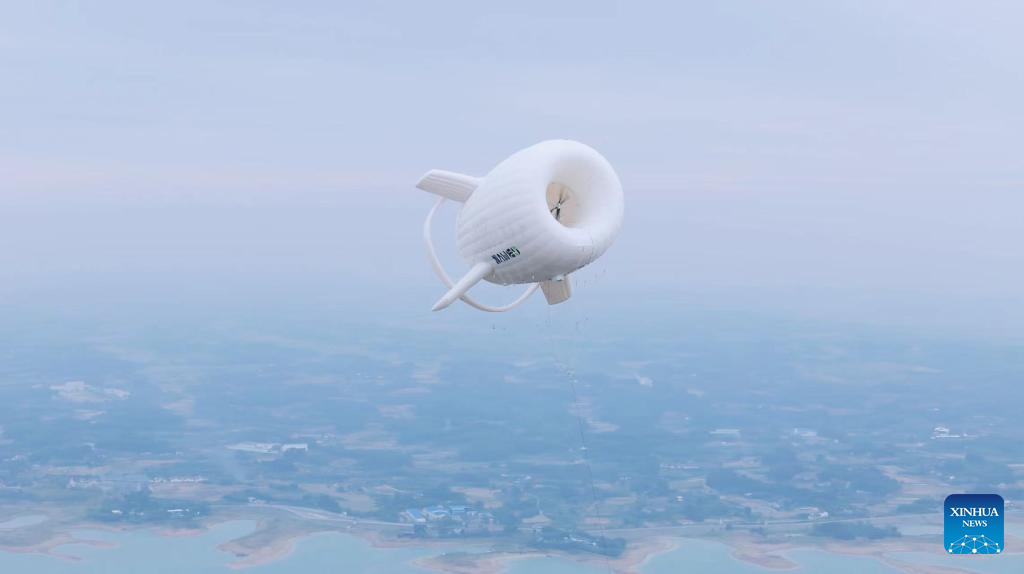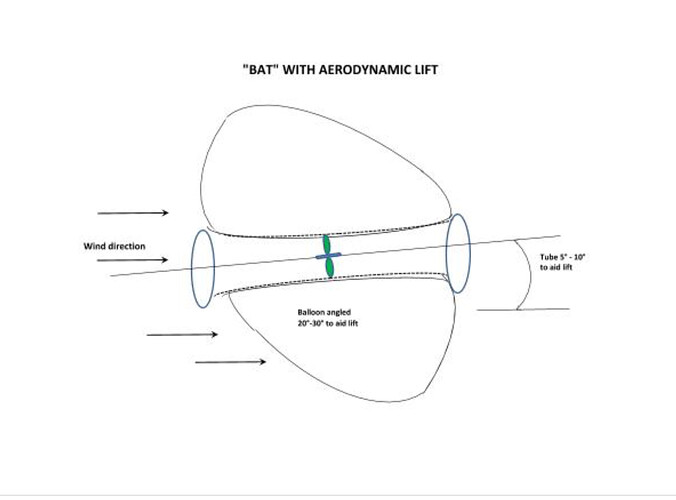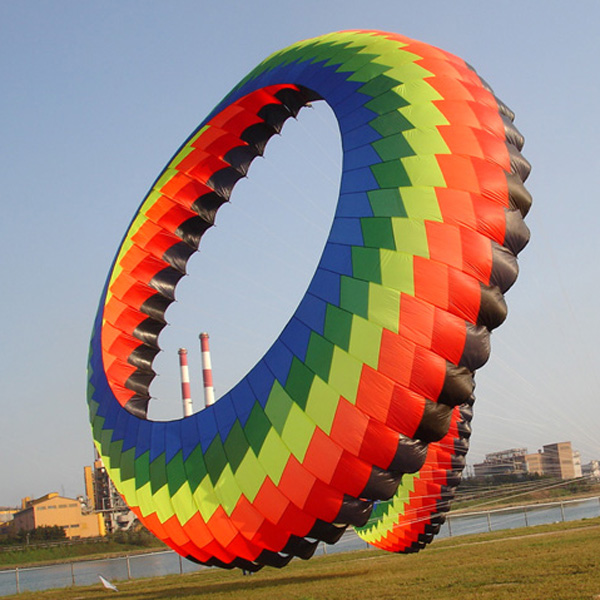And now a video too
If it is used for other applications, it make sense I think.
This information is reported on the video above, at about 2:00. At 5:18, the comment mentions work to improve the lift to drag ratio of the balloon.
It can be noticed that the part around the turbine gradually shrinks, which should increase the amount of wind directed towards the turbine depending on the shrouded device.
The S1000 looks to achieve a real progress in AWE.
At about time = 2:00, you can see the blades of the model shown are about the same length as the height of the person standing on the ground. This represents a 12-foot diameter turbine, good for maybe 2.5 kW in a strong wind.
Most everything said in this video is an outright lie.
These now-ubiquitous “A.I.” (artificial idiocy) -generated videos have become the norm, mispronouncing words, accenting the wrong syllables, losing the context of what the “writing” part of the software “intended” if it was ever capable of “intending” anything at all. The pictures seldom even match the "narration’ at any given moment
They show many completely different models, never specifying which one is the actual focus. They briefly show some Altaeros tabletop models with the Altaeros name shown, but never mention Altaeros specifically, instead claiming this is a Chinese “invention”. Looks to me like more of the same - the copy-cat approach to “innovation”.
What occurred to me the other day is that in this forum, we mostly discuss deceptive press-releases and videos offering deceptive and repetitive “talking points” (like “disaster relief”, or in this case “rescue”. If I had to list every lie in the video, I would be here all day, and would write an entire book worth of text, so I’ll refrain from listing all the lies. Just one was that the Altaeros failure flew for 18 months.
Suffice it to say, anyone who knows anything about LTA aircraft OR wind energy can plainly see this is a bad idea and will go nowhere. Funny how the video breaks off from the subject matter at hand, to a myriad of diversionary peripheral topics. This deception technique is typical of bad wind energy ideas’ promotional scams. Funny how we never see any evidence of the height, such as a side view of it at “1000 meters”, no look at a power meter hitting 100 kW, no evidence of anything said.
And speaking of these diversionary topics, this disinformation is reminiscent of Skysails having “sold 5 AWE systems” - which seems to be nothing but one more inaccurate statement from one more deceptive AWE company. Yet, even skeptical Pierre was saying “We KNOW they sold 5 systems”. That goes to show how easily outright lies can be believed and then repeated until people think they are true, while they are fiction the whole time.
Authors of articles and video producers are encouraged to place a positive spin on their articles in order to get more clicks and views. Meanwhile the record shows they seldom understand even the basics of the subject matter, and almost nothing they say is true.
It would be nice if our AWE discussion had anything left to do besides regurgitating lies from over-eager video producers, lying-ahead-of-any-fact press-releases, and deceptive publicity statements from flailing and often talentless wannabe wind energy business ventures.
What would have been nice is if the pictures matched the narration, and it showed each model, revealing the size, rotor diameter, and height, showing meters running demonstrating the output, rather than showing diversionary views of solar panels, electric cars, and people climbing utility poles, while claiming the device is somehow proven for “rescue” - rescue of what, and where? Same old crap, repackaged to a new level of completely deceptive ridiculousness ![]()
I think we see three different BAT in the video: the S500, the S1000 (bigger), and Altaeros.
About the S500:
About the S1000, see above).
On the S1000 the diameter of the balloon is higher, and probably the same for the diameter of the turbine. That said I am not sure if the balloon is the S500 or S1000 at about 2:00. And also it works like a shrouded turbine, in such a way that the diameter of the balloon is far higher than the diameter of the turbine, the balloon being funnel-shaped. See also my experiment with a propeller within a tire compared to the same propeller alone.
Bon Jour Pierre: OK I’m checking out the video in a separate window.
The first thing the “A.I.” voice says, besides asking you to “like” and “subscribe”, is the following abject and blatant lie:
“China has developed the world’s first airborne wind generation system…”
Really? The first one, huh? The average viewer might actually believe this lie. In this group we know better. Not only is this project FAR from the first AWE system, it is a blatant copy of a long-ago-failed U.S.-originated AWE system: Altaeros.
This sets the tone for the entire video, which amounts to one long, lying advertisement for China.
The images start at time = 0:00 showing a gray cylinder with inflated walls, and a white inflated leading edge, two large, floppy fins hanging down from mid-height at the rear of the cylinder, and one additional fin visibly projecting upward from near the top-rear of the cylinder.
There is no turbine visible inside the cylinder in this initial image.
The white leading edge is smooth, with no black lines.
At time = 0:04 seconds, a close-up shot of a heavy-looking generator with an ugly, industrial appearance is shown, and behind it appears to be the lower surface of the top a white inflated cylinder, with a gray trailing edge crisscrossed by a busy mesh of black fibers in a diamond pattern.
At time = 0:05 seconds, this same generator is seen inside an inflated cylinder, with a transversely-pleated (not smooth) inner and outer surface, like an air-mattress, having what appears to be a shiny silver color, and a grid of black lines over its entire surface. This cylinder does have a visible turbine inside, driving what appears to be the same heavy-looking generator. This actually appears to be the Altaeros AWE attempt, that took place in the USA, NOT China.
By time = 0:09 seconds, we’re treated to an image of a white, cylindrical blimp, having a longitudinally-pleated surface, emblazoned with a banner reading “Lin Yi Yun Chuan Energy”. This tubular blimp has four saggy fins at the rear, interconnected with a large-diameter, saggy ring attached to the ends of the fins, apparently serving as an attempt to stabilize the saggy fins.
Anyway, that looks to be the “50 kW” model, but with a 12-foot diameter rotor, which, even ducted, could come nowhere near that output. Where is the supposed “100 kW” model? Who knows? Why don’t they specify? Because it is all BS! An “A.I.” (artificial idiocy) -generated video that makes no sense at all when carefully scrutinized. It looks to me as though the original messages in this topic are now missing(?)
What I remember was a video that “explained” how American experts were impressed by the Chinese “invention”, or something to that effect. Not to mention one more typical citation of the illogical supposed “use case” of “emergency rescue”, “disaster relief”, etc.
All this stuff is 100% predictable, and quite repetitive. Like symptoms of a disease. I can only point out that the field of AWE is rife with deception, as are self-promotional communications from most wannabe Professor Crackpot supposed “improvements” in wind energy. ![]()
Hi Doug,
Good debunking. But I prefer to relate the positive aspects: it takes up less space! ![]()
Hi Pierre: Yes you are right, considering it took a couple of pages to debunk just the first ten seconds of that deceptive video. The problem is we’ve been treating such blatant lies as fact the whole time, congratulating ourselves at every 100% wrong promise, article, description, or video, treating fiction as fact, often relying on the opinions of loud and abusive know-nothings posing as authoritative sources of facts.
Over here I just woke up, and the first two videos that caught my eye were:
- this know-nothing, deceptive, A.I.-generated video about “advances” in wind energy (vertical-axis wind turbines, supposed 3-D-printed blades cheaper and stronger than regular blades, and of course AWE for “disaster relief”);
Wind Power Advances: Cutting-Edge Technologies Shaping the Future
and
- This video explaining how some recent, more accurate research is “watering down” the previously-reported threat level of rising sea levels. “Follow the science!”:
Scientists Uncover Critical Flaw in Sea-Level Rise Predictions | Watch
Meanwhile, we’ve got a real storm blowing in, and I’ve gotta get out there and turn my real, actual wind turbine that actually DOES power one (1) real, actual house, sideways, before 50 mph wind gusts and near-supersonic raindrops blow it to smithereens! ![]()
Thanks Pierre: I’m going to go a step further. One look at the title and URL of the page from your link, combined with my analysis of just the first ten (10) seconds, reveals the source and deceptive nature of the A.I.-generated content:
The title says “self-generated”, while in just the first few seconds they actually show the original Altaeros BAT, which was the actual first implementation of the idea.
So they are showing the actual original work, as though it is their “original” work, meanwhile there is no credit given to that original work or its inventors and creators. And if you look at the URL of the page, you can see the source has a biased interest, leading an impartial observer to then automatically question every statement made in the video.
That makes me think the entire video is nothing but a deception, designed to impress people, but based on fiction. i would not take one word of it seriously, especially with regard to power output.
Additionally, it points to the real use-case for “A.I.” (artificial idiocy) which is to take deception to the next level - automating it so nobody can even be blamed.
This would explain the puzzling insistence of the leading developers and their funding sources that A.I. is “dangerous” and “must be controlled”. What is so “dangerous” about it? Why must it be “controlled”? Well, could it be that they are worried that A.I. might otherwise tend to expose their own scams and controlling nature?
Meanwhile, and I think you may have touched on this, in order for the BAT to provide aerodynamic lift from its tubular envelope, it must be tilted back, to establish a positive angle of attack. However, that tilts the rotor itself backwards, adding a downward component to its thrust vector, which would tend to push the entire apparatus toward the ground. ![]()
Relevant observation. I also noted this:
“Video unavailable”
“This video has been removed by the uploader” ![]()
It is evident from the literature, that the reason that the “BAT” was not successful, was due to the fact that higher wind velocities caused the device to be forced to the ground. To counteract this, I suggest that the “BAT” be redesigned, so that it is aerodynamically favorable for higher winds. Also the Turbine should be oriented at a slight upward angle to further enhance lift. My concept is shown in the attached sketch. I am sure that this design can be achieved by using “shape wave” technology.
Unfortunately I did not find precise reports about Altaeros and similar devices, with wind speed, turbine diameter and so on.
As I mentioned, it is difficult to reconcile aerodynamic lift and enhanced wind power in flight by shroud effect. That said, some Altaeros photos show a slightly asymmetrical device with an intrados and an extrados.
I think that the drawing above would only make things worse, by increasing the drag, and forcing the air flows towards the extrados and towards the intrados to meet at the trailing edge almost without going through the tunnel. So the turbine, which seems tiny compared to the whole, could not be sufficiently powered. And the construction would be even more complex because of the shape.
I think that in all cases it is not advantageous to reconcile the two functions of shroud and aerodynamic lift.
This is the reason why, having noticed the wind accelerating effect of a well-sized tire that I tested in different conditions, it seemed more judicious to me to separate the shroud effect from the aerodynamic lift which is provided by a kite or a Flettner rotor, leading to simpler elements (torus, and lifter).
Different possibilities, including crosswind and static kites, are described on Flexible kite carrying a turbine within a torus-shaped balloon (Experiment Findings, DOI 10.13140/RG.2.2.29622.00320).
The post @PierreB shared recently on the Spinning Janny and the SpinBox Kite
effectively had a spinning flying shroud
However
I suspect these would be very hard to scale up in ram air form (reliant on a stiffened form other than the spinning bol type which doesn’t lift itself reliably to any useful elevation)
They only rotate from a tiny bearing and bridling so would not be able to generate much (if any) torque as there’s nothing to react against. (maybe you could fly one against a generator from the tail of a more rigid kite / arch?)
Nor do these droopy tail cylinder rotor tubes have much speed, there’s a lot of fabric, rope and stiffener rod being dragging through the air
Hi Gordon. Nice idea, might help somewhat, but the main thing I’ve always noticed about any kind of blimp for wind energy is the fact of wind energy targeting high winds, requiring extremely strong and robust structures to remain operational in those strong winds, whereas blimps tend to be somewhat fragile and even floppy in high winds. Not such a great match overall. To take the long-defunct Altaeros BAT as a main example, with my years of experience having well-built wind energy systems challenged and sometimes destroyed by high winds, I could plainly see the envelope was much too fragile for anything but a light-wind demo. Wind energy wannabe-innovators often tend to envision optimal, fragile-friendly wind conditions, never imagining their pet projects being brutally beaten, and burned-out or blown to the ground, but Mother Nature doesn’t care what we prefer, and instead does what it wants to do, which is often beyond what our devices can reasonably withstand. ![]()
S1500 from SAWES is out apparently https://www.youtube.com/shorts/hmUBjyaFKQs
Interesting video.
S1500 is also mentioned (with S500 and S1000) on:
About S500, S1000 and S1500 (recent update):
Note that in two photos, you can see a few people who give some ideas of the possible scale. Each wind turbine seems to be no more than 4.5 m in diameter (and not 6 m as I had supposed), leading to a swept area of 16 m². To reach 100 kW per turbine, even with an additional 20% efficiency of the duct, as announced in the article, it would require winds close to 30 m/s.
In the other hand, the total weight of a ton with these small wind turbines looks plausible, contrary to what I indicated, but in any case, a ton does not represent a tenth of the weight of a 1 MW wind turbine, but rather a hundredth. And with a wind speed of 12 m/s (already a good speed even at 1500 meters high) the total power of S1500 could be about 100 kW, by taking account of the addition of 20% of the duct.
I only have bits of information, the details of which are essential to determine the true capabilities. A complete description with precise measurements under specific wind conditions would be useful.
S500 has two (2) 7.9-foot blades, and they claim 50 kW. I have a factory-rebuilt 2-blade Whisper 175 from Southwest Windpower here in my garage with two (2) 7-foot blades, rated at 2.5 kW. Because of only two blades, the company drowned in warranty returns, as the 2-bladed turbines ripped themselves apart. Of course, non-wind-energy people know nothing of all this…
I note the photo of the S500 nose shows more buoyant capacity and a smaller comparative tunnel diameter versus Altaeros. That wider tunnel that eliminated a lot of potential buoyancy was a major flaw in the visibly-frail Altaeros design, in my opinion. Then again, such a small rotor is a major flaw in the much larger S500, which must be very expensive at that size. All-in-all, the tunnel-blimp seems, to me anyway, like a flawed concept.
I do not believe the claim of anywhere near 50 kW, but they say it was only a ten-minute fight. Sounds like they brought it down before it flew apart. “We flew it for 10 minutes!” Wow, what a great proof of how reliable it is! Their paper cites a use-case of disaster relief. OMG, how they all have the same repetitive and predictable symptoms! This stuff all gets so repetitive after a while => the copycat approach, the exaggerated output claims, the “disaster relief” meme - how long will people keep swallowing such nonsense?



